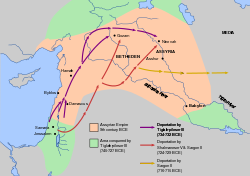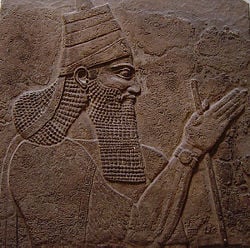Tiglath-Pileser III
Tiglath-Pileser III (from the Hebraic form[1] of Akkadian: Tukultī-apil-Ešarra, "my trust is in the son of Esharra") was a prominent king of Assyria in the eighth century B.C.E. (ruled 745–727 B.C.E.)[2][3] He intiated a major phase of Assyrian expansion and is widely regarded as the founder of the Neo-Assyrian Empire.
Taking his throne name from two earlier Assyrian monarchs to whom he was not physically related, Tiglath-Pileser succeeding in dominating both Syria and Palestine and later accomplished the merger of Babylonia and Assyria, making his kingdom the most powerful in the world.
Assyrian power in the Near East greatly increased as the result of Tiglath-Pileser's military reforms (see "Reforms" below) and his campaigns of conquest. He is considered to be one of the most successful military commanders in history, conquering most of the world known to the ancient Assyrians before his death.
Rise to power
Assyria had been relatively weak both politically and militarily weak the time of Adad-nirari III (reigned 810–783 B.C.E.), and several formal vassal nations had stopping paying tribute formally required. In 745, the future Tiglath-pileser III, then then governor of Kalhu province, rebelled against Adad-nirari III's son, Ashur-nirari V, and seized the throne.
The name Tiglath-Pileser was a throne-name —given to the king on his accession to the throne, rather than a name given at birth. In translation, it means "My Trust is the Heir of Ešarra." The name is given in several different forms in historical records. The Bible records him as Tilgath-pilneser (2 Chronicles 28:20) and also as Pul (1 Chronicles 5:26 and 2 Kings 15:19,20).
In his inscriptions, Tiglath-Pileser refers to himself a son of Adad-nirari III. While it is plausible that he was indeed an otherwise unknown son of Ashur-nirari V's father, the truthfulness of this claim is doubted. It is clear, however, as governor of the northern territory around Nimrud and Nineveh, he seized through through violence.
Tiglath-pileser III acted quickly to consolidate his power and reorganize the territorial administration of Assyria. He subdivided large provinces had sometimes been tempted to opt for independence, while in foreign territories he no longer relied on local kings to abide by treaties of vassalage, but also sent Assyrian officials both to support the local ruler and ensure that he remained loyal. By 738, 80 such provincial administrators were reporting directly to Tiglath-pileser and his secretaries, enabling continuously feedback regarding the situation in outlying lands. The officials were responsible taxation, storing military supplies, and raising forces for the new, reorganized Assyrian army.
A new intelligence system, using reports transmitted by staging posts, was also created.
Reign
In his first regnal year (745) Tiglath-pileser already claimed to have annexed Babylonia, placing his eunuch over them as governor, only he would not claim to have controlled the city of Babylon itself until 729. He also quickly defeated his northern neighbor, Urartu (in modern Armenia), whose hegemony under Sarduri II had extended to northern Mesopotamia and Syria and controlled key trade routes on which Assyrian power relied. Soon also defeated the Medes and then proceeding against the Neo-Hittites, Syria, and Phoenicia.
In Syria, he took Arpad in 740 B.C.E. after three years of siege, destroying the city and annexing its territory as a province of Assyria. He subjected Hamath, located north of Damascus, to tribute. In the same year, Assyrian inscription record a victory over King Azariah (Uzziah) of Judah, whose achievements are described in 2 Chronicles 26. In 733 B.C.E. his armies conquered Philistia on the Mediterranean coast. They destroyed the key Syrian city ofDamascus and occupied most of the ancient kingdom of Israel (732), with its northern regions becoming Assyrian provinces. Royal inscriptions of Tiglath-Pileser indicate that many of Israel's inhabitants were deported to other parts of the Assyrian empire, a practice that was commonly enacted by his predecessors and would be repeated by his successors.
The the east, by October 729, Tiglath-Pileser claimed to have assumed total control of Babylon, capturing the Babylonian king Nabu-mukin-zeri and having himself crowned as "King Pulu of Babylon."
Biblical records

Biblical records, corroborated by Assyrian ones, describe how Tiglath-Pileser III exacted 1000 talents of silver tribute from King Menahem of Israel (2 Kings 15:19) and defeated his successor Pekah (15:29). Pekah had allied with Rezin, king of the Arameans against Ahaz (known to the Assyrians as Yahu-khazi), king of Judah, who responded by appealing for the Assyrian monarch's help with the Temple gold and silver. Tiglath-Pileser complied by seizing Damascus, executing Rezin, and deporting the Aramaean inhabitants to Kir (16:9). He also seized the northern half of Israel, and deported the Reubenites, Gadites, and Manasseh to Halah, Habor, Hara, and the Gozan river (1 Chron. 5:26). Despite the alliance, he apparently caused some trouble for Ahaz as well (2 Chron 28:20).
Reforms
Upon ascending the throne, Tiglath-Pileser instituted several reforms to different sectors of the Assyrian state, which arguably revived Assyria's hegemony over the Near East.
The first of such reforms entailed thwarting the powers of the high Assyrian officials, which during the reigns of his predecessors had become exceedingly high. Officials such as Šamši-ilu, who was turtanu and a prominent official since the time of Adad-Nirari III, often led their own campaigns and erected their own commemorative stelae, often without mentioning the king at all[5]. Since his earliest inscriptions (and thus from the beginning of his reign), he gave regular mention of appointing eunuchs as governors of (newly conquered) provinces; this removed the threat of provincial rule becoming a dynastic matter. He also sought to reduce the power of his officials by reducing the size of the provinces (in some cases the northern provinces were increased to include newly conquered territories), thus decreasing their resources, should they have desired to incite a revolt. Subsequently, there were more provinces, more governors (most of which were eunuchs), and less power per governor.
The second reform targeted the army. Instead of a largely native Assyrian army which normally campaigned only in the summer time, Tiglath-Pileser incorporated large numbers of conquered people into the army, thus adding a substantial foreign element. This force mainly comprised the infantry, whereas the native Assyrians comprised the cavalry and chariotry. As a result of Tiglath-Pileser's military reforms, the Assyrian Empire was armed with a greatly expanded army which could campaign throughout the year.
Campaigns
Legacy
Tiglath-Pileser III's conquests and reforms led to the establishment of the Neo-Assyrian Kingdom as a true empire. He built a royal palace in Nimrud (the so-called "central palace") later to be dismantled by Esarhaddon. On the sculptured slabs decorating his palace, across the bas-reliefs depicting his military achievements, he had engraved his royal annals.
On his death, he was succeeded by his son Ululayu, who took the name Shalmaneser V, who further campaigned in the Levant and captured Samaria.
See also
Template:ANE portal
- Kings of Assyria
Notes
ReferencesISBN links support NWE through referral fees
- Healy, Mark. The Ancient Assyrians, Tiglath-Pileser III, London: Osprey publ. ISBN 1855321637, OCLC 26351868
| Preceded by: Ashur-nirari V |
King of Assyria 745–727 B.C.E. |
Succeeded by: Shalmaneser V |
| Preceded by: Nabu-mukin-zeri |
King of Babylon 729–727 B.C.E. |
Template:Assyrian kings
Credits
New World Encyclopedia writers and editors rewrote and completed the Wikipedia article in accordance with New World Encyclopedia standards. This article abides by terms of the Creative Commons CC-by-sa 3.0 License (CC-by-sa), which may be used and disseminated with proper attribution. Credit is due under the terms of this license that can reference both the New World Encyclopedia contributors and the selfless volunteer contributors of the Wikimedia Foundation. To cite this article click here for a list of acceptable citing formats.The history of earlier contributions by wikipedians is accessible to researchers here:
The history of this article since it was imported to New World Encyclopedia:
Note: Some restrictions may apply to use of individual images which are separately licensed.

